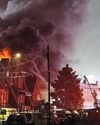CATEGORIES
Categories

ANIMAL SHAPES TURN CUSTOMERS INTO FANS
The daily victories in our lives aren't punctuated with ceremony or fanfare; rather, they are acknowledged with small rewards and simple pleasures. Sweets typify the prize for these small triumphs with a moment of delight that compliments the sense of accomplishment. Ginbis Co., Ltd., are a manufacturer of sweets that company President Shuji Miyamoto says delivers joy and vitality to people around the world. “We want to be known as a company that delivers sweets that are memorable in one’s lifetime,” he says.

Inside William's Private World
In a new interview, Prince William’s former right-hand man reveals what the future king is really like behind the scenes

SELLECK BLOOD FEUD OVER DONNIE'S BETRAYAL!
Protégé Wahlberg steals show from under Tom's nose

LINDSAY'S DAD CUFFED IN ATTACK ON EX-WIFE!
FREAKY father Michael Lohan has been collared for allegedly assaulting his estranged wife, Kate Major.

IT'S BIGFOOT vs GRIZZLY IN CALIFORNIA!
Lawman proposes mythical monster as new mascot

I Always Wanted To Play This Role
How the TV legend overcame his reservations about returning to the small screen for his new show

VANNA HAS NO TIME FOR LOVE!
LEGGY letter-turner Vanna White is putting romance on the back burner as she spins about the changes on Wheel of Fortune - and her soaring stress isn't helping the game show gal's relationship with devoted beau John Donaldson, sources snitch.

GOSSIP GIRL STAR'S Tragic Death
Hollywood was left reeling after Michelle Trachtenberg was found dead at the age of 39 at her NYC apartment on Feb. 26.

STARVING FOR ATTENTION!
Fears as severe weight loss turns celebs into wraiths

BRUCE WILLIS MY LIFE IN 10 Pictures
GROWING UP in Penns Grove, N.J, Walter Bruce Willis wasn't the wisecracking everyman that brought him fame.

RELEASED KILLER CANNIBAL HUNGRY FOR FREEDOM!
Shocking decision lets him out after 12 yrs in loony bin

OBAMA'S SECRET LOVER SPILLS BARACK'S BEANS!
Sex details drive Michelle mad as marriage founders

FLYING THE UNFRIENDLY SKIES AFTER DISASTER!
Here’s why air travel is still a safe bet

Paul W.S.Anderson & Milla Jovovich
On the eve of their ninth film, In the Lost Lands, the spouses talk working together, the \"electricity\" of their first meeting... and that black eye she gave him

25 THINGS YOU DON'T KNOW ABOUT ME
The actress divulges some personal truths, including how Minnie Driver once supported her on set!

Moving On From the Mayhem
It's back to business for The Rookie's Jenna Dewan on-screen and on the set

We Love LUCY'S STYLE
THE LOOK OF TELEVISION'S COMEDY QUEEN EVOLVED OVER TIME

JOSH & HAILEE Full Speed Ahead
Now that the Buffalo Bills quarterback's season is over, the duo is focused on wedding planning

Musk Makes His German Mark
AfD's rise to become the second-largest party in Bundestag is a boost to the country's conservative movement—and Elon Musk

White-Collar Recession
Why unemployed Americans in the professional and business service sector are struggling to find new jobs

The Battle Over RICHARD SIMMONS' Fortune
Seven months after the fitness icon's death, his brother and housekeeper are at war over his estate

ARREST IN CASE OF MISSING BABY MADDIE!
Tiny breakthrough after 18 heartbreaking years

ROBERTA FLACK (1937-2025) FAREWELL TO A MUSIC LEGEND
Roberta Flack, the legendary singer-songwriter whose soulful voice captivated generations of music lovers, died on Feb. 24 from cardiac arrest, a complication of ALS.

New Details MANSON About MURDERS
A NETFLIX DOCUMENTARY POSES SOME THOUGHT-PROVOKING THEORIES ABOUT THE 1960s MOST INFAMOUS KILLING SPREE

MSNBC DEATH SPIRAL!
Network throws talent overboard in 'bloodbath'

KYLIE TRYING TO FATTEN UP TIMOTHÉE!
MAKEUP mogul Kylie Jenner is head over heels for Timothée Chalamet, but sources tattle that she wishes the Dune hero would put more meat on his bony frame, and she's also pushing the Oscar favorite to hit the gym more.

JEN & ELLEN AMP UP FEUD AS STAKES RISE!
Competition to see who's the best stream queen

JUSTIN & HAILEY CAN'T MAKE A MOVE WITHOUT SHRINK!
Need couples therapy to navigate rapids

Jessie James Decker 'I Like the Way ILook Now
More Than When I Was 23' Hot mama! Jessie James Decker dishes on getting into peak physical shape, her new swimsuit collection and life as a family of six

KIM'S SEXY GAME PLAN FOR PETE!
HOT-TO-TROT Kim Kardashian is thrilled to have reconnected with ex-love Pete Davidson at the SNL 50th anniversary party, and sources say that even if the comic is not up for another full-blown romance, the Skims hawker is pushing for the next best thing - a no-strings booty-call setup!